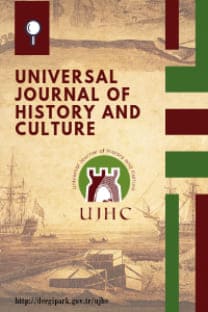Doğulaşma ve Edebiyat
Doğu dünya görüşlerinden etkilenen Batının kültürel Doğulaşmaya maruz kaldığını ve buna bağlı olarak dünya edebiyatı okurlarının yaklaşımlarında değişiklik yaşandığı gözlemlenmektedir. Doğu merkezli roman yazarlarının Batı’daki satışlarının istatistiksel olarak incelenmesi veya Batılı okurlar tarafından Doğu kültürü hakkında popüler konuları incelemek yerine, bu makale, Edebi Doğulaşma teorisini savunmak için batıda çok satan Orhan Pamuk’un eserlerini uygun bir örnek olarak ele almıştır. Pamuk’un, Batılı okuyucular tarafından benimsenmesi ve popüler eserlerindeki Doğu kültürünün değerlerini yansıtması, küresel olarak dünya edebiyatının az bilinen kültürlerine artan ilginin bariz bir örneğidir. Bu anlamda, bu makalede enine boyuna savunulan ‘Edebi Doğulaşma’ teorisi ve Batı dünya görüşlerinin Doğu dünya görüşleriyle ihtilât edilmesi, en açıklayıcı örneklerle ortaya koyulmuştur. Şimdilerde örnek gösterilen edebi eserler bile bu geçiş dönemini veya oryantasyon dönümünü doğru anlamamızı sağlamış değillerdir. Hatta daha az eleştirilmeye maruz kalan edebi eserlerden örnek göstermek bile, bu oryantasyon sürecini doğru algılamamızı sağlayamayabilir. Örneğin, başlıkta ‘harem’ kelimesi ile süslenen romanlar Batılı okuyucular tarafından oldukça rağbet görmesi ve üstelik buna benzer egzotik başlıklar ile yayınlanan eserler, kitabın Batı ülkelerinde iyi satış oranını garantiliyor. Ancak bu şekilde başlıklara dayanarak, sonuca varmak yanıltıcı olabilir. Bu nedenle, Doğulaşmanın temel işlevlerini edebi bir çalışmada, edebi teoriler ile belirtmek, bu ve ya benzer bir terimin sübvansiyonunu kolaylaştırır. Metinlerarasılık gibi edebiyatta baskın olan teorilerden yararlanan Pamuk, eserlerinde gizli olan Batı ve Doğu dünya görüşlerini kıyaslayarak, farklı bir şekilde her birinin tanımına yol açmaktadır.
Anahtar Kelimeler:
Edebi Doğulaşma, Doğulaşmak, Edebi Uyum, Metinlerarasılık, Orhan Pamuk
Easternization and Literature
In general, every human being experiences existential disappointment in a time between his birth and his death. Presented to the man with a short life span, we spend most of our life intertwined with many negative and positive factors, by thinking over the reasons having deep effect on our life. The aim of this article is to enter into an interrogation of Spinoza’s work, Ethica, which may be the subject of philosophical therapy in the direction of how we can get rid of the unnecessary thought burdens that steal our time and make us tired.The West gradually influenced by Eastern world views that were exposed to cultural Easternization. Accordingly, changes in the approaches of globally literature readers are observed. Rather than analyzing the sale rates of Eastern-origin novelists in the West or examining popular issues about Eastern culture by Western readers, this article considers the best-selling author, Orhan Pamuk’s works in the West to defend the Literary Easternization theory. The adoption of Pamuk by Western readers and reflecting the values of Eastern culture in his popular works is a clear example of the globally growing interest in the lesser-known cultures of World Literature. In this sense, the ‘Literary Easternization’ theory, which is advocated in detail in this article and the contradiction of Western worldviews with Eastern worldviews has been put forward with the most illustrative instances. Even though the literary works that are exemplified may not provide us with an overall understanding of this transition period or the turning of orientation, but arraying examples of less criticized literary works may not allow us to perceive this orientation process appropriately. For example, the novels adorned with the word ‘harem’ in the title are highly sought after by Western readers and helps the books to guarantee good sales in Western countries. However, based on such headings, it may be misleading to draw a conclusion to this topic. To define the essential functions of Easternization by literary theories, this or a similar term facilitates the subsidy in a literary work. Taking advantage of the dominant theories in literature such as intertextuality, Pamuk leads to the definition of each in a different way by comparing the Western and Eastern worldviews that are hidden in his works.}
Keywords:
Literary Easternization, Easternization, Literary Adaptation, Intertextuality, Orhan Pamuk,
___
- Anderson, B. (1991). Imagined communities: Reflections on the origin and spread of nationalism. London: Verso.
- Appiah, K. A. (2006). Cosmopolitanism: Ethics in a world of strangers. New York: W.W. Norton & Co.
- Bhabha, H. K. (1994). The location of culture. New York: Routledge.
- Campbell, C. (2007). The easternization of the west: A thematic account of cultural change in the modern era. Boulder, CO: Paradigm Publishers.
- Cesaire, A. (2000). Discourse on colonialism (J. Pinkham, Trans.). NewYork: Monthly Review Press.
- Damrosch, D. (2003). What is world literature? NJ: Princeton University Press.
- Huntington, S. P. (1996). The clash of civilizations and the remaking of world order. New York: Simon & Schuster.
- Meriç, C. (2005). Bu ülke, Cemil Meriç bütün eserleri 2. İstanbul: İletişim Yayınları.
- Pamuk, O. (2006). The black book (M. Freely, Trans.). London: Faber.
- Pantham, T. (1992). Some dimensions of the universality of philosophical hermeneutics: A conversation with Hans-Georg Gadamer. Journal of Indian Council of Philosophical Research, 9(3), 123–35.
- Said, E. W. (2003). Orientalism. London: Penguin.
- Todorov, T. (2010). The fear of barbarians: Beyond the clash of civilizations. Chicago: University of Chicago Press.
- Turner, B. S. (1994). Orientalism, postmodernism, and globalism. London: Routledge.
- ISSN: 2667-8179
- Başlangıç: 2019
- Yayıncı: Orhan TURAN
Sayıdaki Diğer Makaleler
Colonial Attempts to Control and Overcome Nature in Prospero's Daughter
Beyit ve Dize: Karşılaştırmalı Şiirsel Analiz
Geçmişi Kullanma Kılavuzu Tarih, Bellek, Politika
Iki Dil, İki Halk, Tek Cografya: Luvi-Arami İlişkileri (MO 1050-750)
Engin Durukan ABDULHAKİMOĞULLARI
Yabancı Kaynaklarda Karşılaştırmalı Edebiyat Alanına Nesimi'nin Rolü
Batman’da 6-12 Yaş Aralığındaki Çocukların Dijital Medya Araçları Kullanımına Annelerin Bakışı
